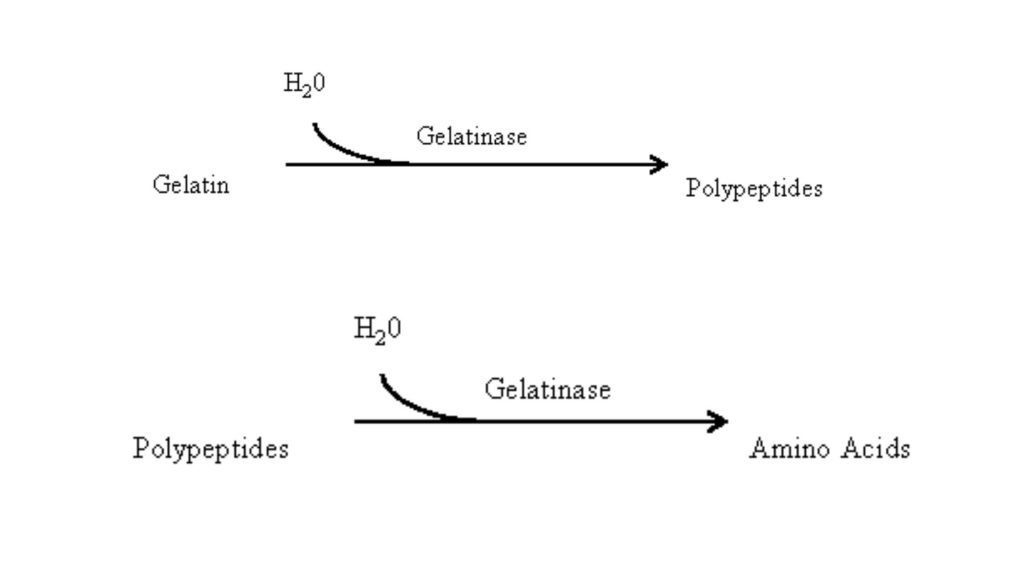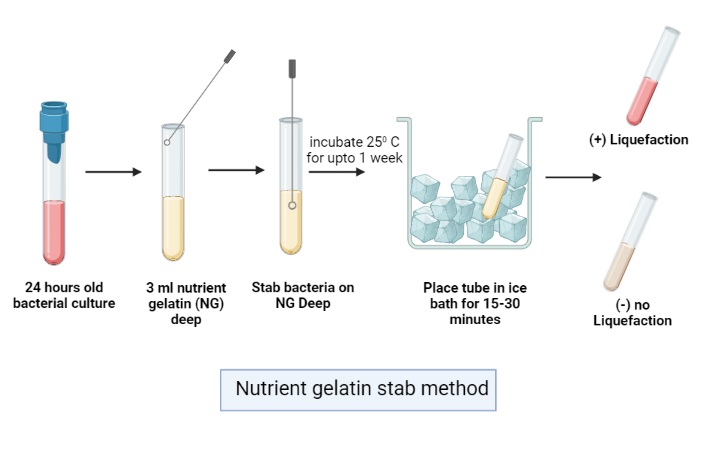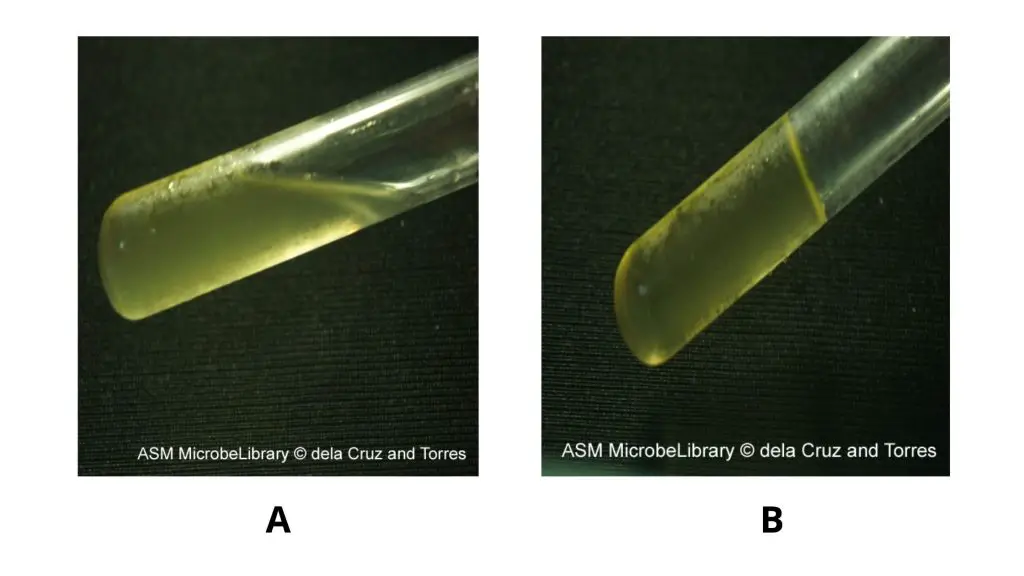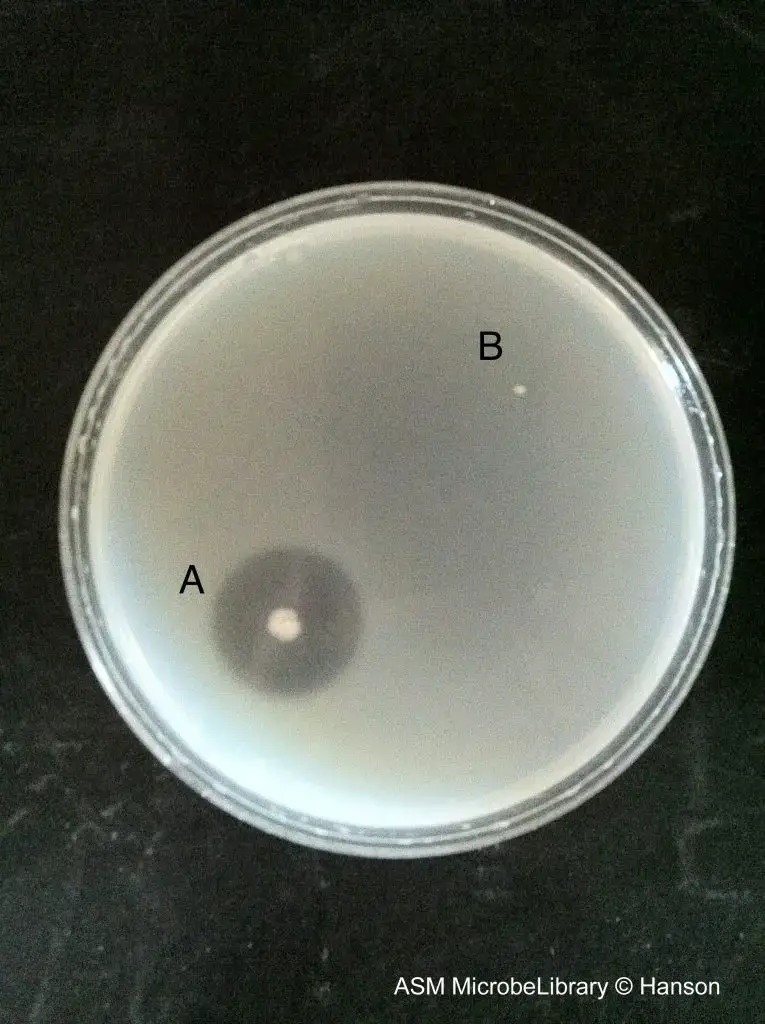Gelatin is a protein that comes from animal collagen, a component of the vertebrate connective tissues. For a long time, gelatin has been used in food solidification. Organisms that produce proteolytic enzymes (gelatinases) hydrolyze gelatin to make polypeptides or individual amino acids. Gelatin is made liquid by this process.
Contents
Gelatin Hydrolysis Test Background
- The technique by which we can detect the ability of microorganisms to liquefy gelatin was first described by Frazier, in 1926.
- In this technique, the microorganisms are grown on a low-peptone agar medium supplemented with gelatin. Then the plates are treated with acidic mercuric chloride or tannic acid to detect the digestion of gelatin.
- The method was tested against isolated intestinal Gram-negative bacilli by Barer and against aerobic spore-forming bacilli by Smith, Gordon, and Clarke in 1946 as mentioned by Clarke. The method for gelatin hydrolysis was then listed as one of the biochemical tests for bacteriology.
- Later Clarke (1953) reported a simplified plate technique applying 10% leaf gelatin and HgCl 2–HCl solution for the identification of gelatin-liquefying bacteria and compared it with the gelatin stab method and Frazier’s plate method.
- This observation revealed that hydrolysis of gelatin was usually more reliable and rapid in the simplified plate technique(3 days) than in the stab method (up to 14 days) and Frazier’s plate method (up to 4 days).
- Green and Larks (1955) also published a quick technique for the identification of gelatin-liquefying bacteria applying formalin-denatured gelatin-charcoal. In this technique, gelatin hydrolysis was seen when charcoal particles were released and resolved to the bottom of the culture tube. This technique was discovered to be quicker than the gelatin stab technique.
Gelatin Hydrolysis Test Overview
- It is a type of biochemical test which is used for the identification of Staphylococcus, Enterococcus, and other Gram-positive bacilli.
- In this test the liquefaction of gelatin occurs in the presence of the gelatinase enzyme, that’s why it’s also known as the Gelatin Liquefaction test.
- In pathogenic organisms, Gelatinase is an essential enzyme which is produced extracellularly. This enzyme mainly hydrolyses gelatin which is a protein obtained from the collagen found in the connective tissues of vertebrates.
- Gelatinase might play as a virulence factor as its dissolves the connective tissues of the host’s cells which aids in invasive infections.
- The gelatinase enzyme liquefies the Gelatin protein by breaking the complex structure of gelatin into monomeric amino acids.
- The production of gelatinases capable of hydrolyzing gelatin is used as a presumptive test for the identification of various organisms, including Staphylococcus spp., Enterobacteriaceae, and some gram-positive bacilli.
Purpose of gelatin hydrolysis test
There are the different purpose of the Gelatin hydrolysis test such as;
- To detects the ability of bacteria to produce gelatinases.
- To identify the Serratia, Pseudomonas, Flavobacterium, and Clostridium.
- To distinguishes the gelatinase-positive, pathogenic Staphylococcus aureus from the gelatinase-negative, nonpathogenic Staphylococcus epidermidis.
- To detect the Gram-positive, spore-forming, rod-shaped, aerobic or anaerobic bacteria such as Bacillus anthracis, B. cereus, B. subtilis, Clostridium perfringens and C. tetani.
- Used to differentiate genera of gelatinase-producing bacteria such as Serratia and Proteus from other members of the family Enterobacteriaceae.
Gelatin hydrolysis test Principle
The gelatin proteins derived from the animal connective tissue, collagen. Gelatin is produced when collagen is boiled in water. A gelatin hydrolysis test is used to detects the presence of gelatinases. Gelatinases are extracellularly secreted by some bacteria which hydrolyze or digest gelatin.
The hydrolysis/digest process of gelatin is takes place in two sequential reactions. In the first reaction, gelatinases degrade gelatin to polypeptides. Then in the second step, the polypeptides are further converted into amino acids.

For the detection of Gelatin hydrolysis, a nutrient media is used known as gelatin medium. This gelatin medium is a mixture of peptic digest of animal tissue (peptone), beef extract, and gelatin. The gelatine helps to solidify the medium and as well as functions as a substrate for gelatinase activity. When nutrient gelatin tubes are stab-inoculated with a gelatinase-positive bacterium, the secreted gelatinases will hydrolyze the gelatin resulting in the liquefaction of the medium. Since gelatin is digested and is no longer able to gel, the medium will remain liquid when placed inside a refrigerator or in an ice bath.
A nutrient gelatin medium inoculated with a gelatinase-negative bacterium will remain solid after the cold treatment. The medium can be inoculated with both aerobic and anaerobic bacteria and incubated as appropriate.
Requirement
- Nutrient Gelatin Media
- Mercuric chloride (HgCl2)
- Inoculating needle
- Incubator at 37°C
- Pipettes
Nutrient Gelatin Media Preparation
The following components are required to prepare Nutrient gelatin media;
| Peptone | 5.0g/liter |
| Beef extract | 3.0 g/liter |
| Gelatin | 120.0 g/liter |
Nutrient Gelatin Media Preparation Steps
- Mix all ingredients in 1,000 ml of distilled or deionized water and heating gently to dissolve them.
- After that, the medium is dispensed into 13- by 100-mm culture tubes.
- Autoclave the tubes at 121 oC (15 psi) for 15 minutes.
- Before using the media, allow them to cool in an upright position.
- Store them at 2 to 8 oC. This stored media can be used until its expiration date.
- Avoid using a tubed medium which are shows signs of microbial contamination, discoloration, drying, or other signs of deterioration.
- The final pH would be 6.8 ± 0.2 at 25°C.
Gelatin hydrolysis test Procedure
There are present two methods for the Gelatin hydrolysis test such as;
Nutrient gelatin stab method
All the methods used for the detection of gelatinase production, all contain gelatin as the substrate. The nutrient gelatin stab method is the standard and most commonly employed method. This method gives easy and accurate results (medium liquefaction) and reduces the use of reagents or chemicals that may be dangerous to health.
- Stab-inoculate the inoculum of an 18- to 24-hour-old test bacteria into the tubes containing nutrient gelatin.
- Incubate the tubes along with the control tube at 25°C, or at the test bacterium’s optimal growth temperature, for up to 1 week, and check everyday for gelatin liquefaction.
- Gelatin usually liquefies at 28°C and above, so to endorse that liquefaction was due to gelatinase activity, the tubes are dipped in an ice bath for 15 to 30 minutes.
- Afterward, tubes are tilted to observe if gelatin has been hydrolyzed.
- The hydrolyzed gelatin will result in a liquid medium even after exposure to cold temperature (ice bath), while the uninoculated control medium will remain solid.
- For weak positive results, incubate the inoculated nutrient gelatin tube longer until complete liquefaction is observed. The hydrolysis of gelatin indicates the secretion of gelatinase by the test organism into the medium.
- Note that some bacterial species, e.g., Proteus vulgaris, may require up to 14 days of incubation to yield a positive result.
- Aseptic techniques and appropriate biosafety protocols should always be strictly observed and practiced in the microbiology laboratory.

Some gelatinase-positive organisms in nutrient gelatin stab method can produce the enzyme at a slower rate. Thus, the following tips are recommended:
- Stab-inoculate nutrient gelatin tubes with a heavy inoculum of the test bacteria.
- Incubate nutrient gelatin tubes for a longer period (7 days up to 14 days).
- Use smaller test tubes for the nutrient gelatin medium (13 by 100 mm).
- Use a smaller volume of nutrient gelatin (2 to 3 ml) in the tubes.
Nutrient gelatin plate method
This is an alternative method for the detection of gelatin hydrolysis in the nutrient gelatin plate. This method is completed in the following steps;
- Stab-inoculate the inoculum of an 18- to 24-hour-old test bacteria on culture plates prefilled with nutrient gelatin (23 g/liter nutrient agar, 8 g/liter gelatin).
- After inoculation, incubate the plates at 35 oC for 24 hours.
- After incubation, the clear zones around gelatinase-positive colonies indicate the Gelatin hydrolysis.
- Flood the plates with saturated ammonium sulfate, it will help to precipitate the unhydrolyzed gelatin, as a result, it will make the clear zones easier to see.
- Observe the plates within 5 to 10 minutes after flooding with saturated ammonium sulfate
Note: Another alternative medium for the nutrient gelatin plate method is consists of 4 g/liter of peptone, 1 g/liter of yeast extract, 12 g/liter of gelatin, and 15 g/liter of agar. In most cases, this medium provides a visible zone without treatment by saturated ammonium sulfate.
Gelatin hydrolysis test results
Tube test Result
- Positive gelatin hydrolysis test: Partial or total liquefaction of the inoculated tube (the control tube must be completely solidified) at 4°C within 14 days.
- Negative gelatin hydrolysis test: Indicated by the Complete solidification of gelatin at 4°C.

For the nutrient gelatin stab method, it should be noted that some gelatinase-positive organisms produce the enzyme at a slower rate. These are some of the best tips you can use.
- Stab-inoculate nutrient gellatin tubes with a heavy dose of test bacteria
- For a longer time, incubate the nutrient gelatin tubes (7 to 14 days).
- For the nutrient gelatin medium, use smaller test tubes (13 x 100 mm).
- You can use a smaller amount of nutrient gellatin (2 to 3 milliliters) in your tubes.
Plate Method Result
- Positive gelatin hydrolysis test: Formation of a clear zone around the colonies after the addition of mercuric chloride (HgCl2).
- Negative gelatin hydrolysis test: No clear zones formed around the colonies after the addition of mercuric chloride.

List of common bacteria and their reactions to the gelatin hydrolysis test performed on nutrient gelatin
| Species | Biosafety level | Growth | Liquefaction |
| Bacillus subtilis | 1 | + | + |
| Clostridium perfringens | 1 or 2 | + | + |
| Escherichia coli | 1 | + | – |
| Proteus vulgaris | 1 | + | + |
| Serratia liquefaciens | 1 | + | + |
| Staphylococcus aureus | 1 | + | + |
Quality Control of Gelatin hydrolysis test
For positive and negative Quality Control of Gelatin hydrolysis test, two organisms are used such as;
- Positive Quality Control: Bacillus subtilis
- Negative Quality Control: Escherichia coli
- Uninoculated control tube: medium becomes solid after refrigeration.
Gelatin hydrolysis test Uses
- Gelatin hydrolysis test Use to detects the ability of bacteria to produce gelatinases.
- It is used to identify the Serratia, Pseudomonas, Flavobacterium, and Clostridium.
- Used to distinguishes the gelatinase-positive, pathogenic Staphylococcus aureus from the gelatinase-negative, nonpathogenic Staphylococcus epidermidis.
- USed to detect the Gram-positive, spore-forming, rod-shaped, aerobic or anaerobic bacteria such as Bacillus anthracis, B. cereus, B. subtilis, Clostridium perfringens and C. tetani.
- Used to differentiate genera of gelatinase-producing bacteria such as Serratia and Proteus from other members of the family Enterobacteriaceae.
Gelatin hydrolysis test limitation
- Shaking the tube when it’s warm may lead to a false-negative result, because Gelatinase acts at the surface of the tube medium.
- Don’t incubate the tubes for more than 4 hours, it may lead to a false-positive result.
- For fastidious species and obligate anaerobes, the plate method is not recommended.
- During incubation, if the tubes are kept at temperatures greater than 20°C, therefore the tubes must be chilled below 20°C before performing the reactions.
- The gelling ability of Gelatin may vary that’s why an uninoculated control should be inoculated with the test. It must be refrigerated along with the test, prior to reading.
FAQ
It is a type of biochemical test which is used for the identification of Staphylococcus, Enterococcus, and other Gram-positive bacilli.
In this test the liquefaction of gelatin occurs in the presence of the gelatinase enzyme, that’s why it’s also known as the Gelatin Liquefaction test.
In pathogenic organisms, Gelatinase is an essential enzyme which is produced extracellularly. This enzyme mainly hydrolyses gelatin which is a protein obtained from the collagen found in the connective tissues of vertebrates.
Gelatinase might play as a virulence factor as its dissolves the connective tissues of the host’s cells which aids in invasive infections.
The gelatinase enzyme liquefies the Gelatin protein by breaking the complex structure of gelatin into monomeric amino acids.
The production of gelatinases capable of hydrolyzing gelatin is used as a presumptive test for the identification of various organisms, including Staphylococcus spp., Enterobacteriaceae, and some gram-positive bacilli.
The gelatin hydrolysis test detects the ability of bacteria to produce gelatinases. This test aids in the identification of Serratia, Pseudomonas, Flavobacterium and Clostridium.
There are the different purpose of the Gelatin hydrolysis test such as;
1. To detects the ability of bacteria to produce gelatinases.
2. To identify the Serratia, Pseudomonas, Flavobacterium, and Clostridium.
3. To distinguishes the gelatinase-positive, pathogenic Staphylococcus aureus from the gelatinase-negative, nonpathogenic Staphylococcus epidermidis.
4. To detect the Gram-positive, spore-forming, rod-shaped, aerobic or anaerobic bacteria such as Bacillus anthracis, B. cereus, B. subtilis, Clostridium perfringens and C. tetani.
5. Used to differentiate genera of gelatinase-producing bacteria such as Serratia and Proteus from other members of the family Enterobacteriaceae.
The gelatin hydrolysis test detects the ability of bacteria to produce gelatinases.
Plate Method Result: Formation of a clear zone around the colonies after the addition of mercuric chloride (HgCl2) is a indication of positive test for gelatin hydrolysis
Tube test Result: Partial or total liquefaction of the inoculated tube (the control tube must be completely solidified) at 4°C within 14 days, is a indication of positive test for gelatin hydrolysis
Gelatin substrate is present in gelatin hydrolysis test
Gelatinases (Enzyme) hydrolyze gelatin (Substrate) into polypeptides and then polypeptides are further converted into amino acids (Product). The amino acid is taken up by the cell and used for metabolic purposes.
References
- https://www.asmscience.org/content/education/protocol/protocol.3776
- https://microbenotes.com/gelatin-hydrolysis-test-principle-procedure-and-result-interpretation/#limitations-of-gelatin-hydrolysis-test
- https://microbiologyinfo.com/gelatin-hydrolysis-test/
- https://microbeonline.com/gelatin-hydrolysis-test/
- Bailey & Scott’s Diagnostic Microbiology, Forbes, 11th edition
- Koneman’s Color Atlas and Textbook of Diagnostic Microbiology
- https://www.onlinebiologynotes.com/gelatin-hydrolysis-test-principle-procedure/
- https://microbiologynotes.com/gelatin-hydrolysis-test-principle-uses-media-procedure-and-result/











